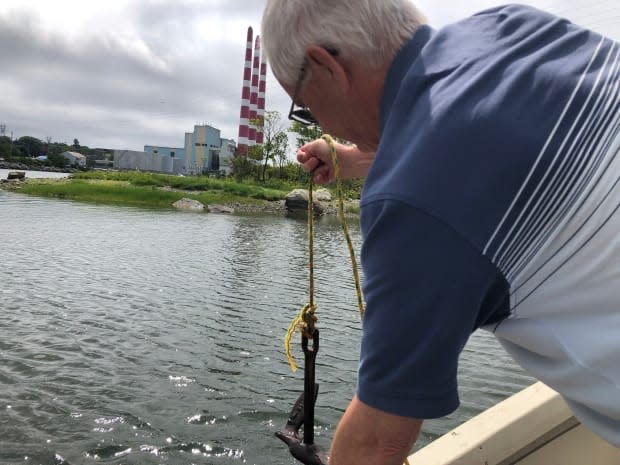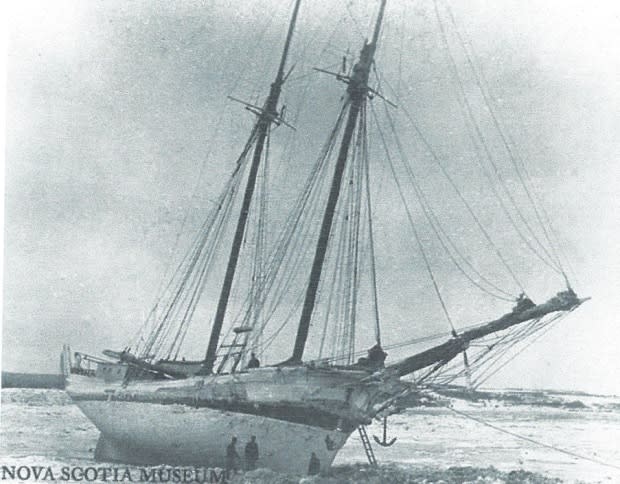Surprise find in Halifax harbour anchors diver's theory on 1917 explosion

A Halifax scuba diver has found something that could shed a little new light on one aspect of a dark chapter in Nova Scotian history.
Bob Chaulk has explored Halifax harbour from the Bedford Basin to Chebucto Head with hundreds of scuba dives over the last 30 years. But this spring, a routine dive in a small cove in the Narrows between Halifax's two bridges led him to a big find.
Amid the usual assortment of scuttling crabs, polished bottles and bits of plastic trash, he came upon a huge, heavy object in Tufts Cove.
"When I first saw the anchor, I thought, OK, there's a wreck here, some old derelict came in here. But there's no way a ship that size could have gotten in here," he said.

He explored until his air just about ran out. He estimated the anchor was about two metres long and weighed 135 kilograms. A ship that needed an anchor that size could not have sailed into shallow, rocky Tufts Cove, he thought.
So how did the old anchor get there?
He looked across the Narrows and found himself staring right at ground zero for the Halifax Explosion, which killed nearly 2,000 people. On Dec. 6, 1917, the vessel Imo and the Mont Blanc, a ship carrying explosive cargo, collided. The Mont Blanc caught fire and drifted into Pier 6, a space occupied today by the giant Halifax Shipyard building. The St. Bernard, a lumber schooner, was also at the dock.

"So now you have two ships side by side with a dock in between them. Here's the Mont Blanc, here's the Imo," Chaulk said, showing the ships' positions with his hands. "This one blows up, destroys this one, and I contend the anchor [of the St. Bernard] went through the air and landed right here."
The St. Bernard was blasted to pieces and never seen again. While the wood from the ship would have splintered and been destroyed, its heavy metal parts would have survived. If he's right, Chaulk has found a remnant of the schooner.
The location of the find would have meant the anchor landed dangerously close to the crew of the Mont Blanc, who had fled into the Mi'kmaw village of Kepe'kek at Turtle Grove, as Tufts Cove is also known.
The Mont Blanc's much heavier anchor was found four kilometres away from the blast, near the portion of the harbour known as Northwest Arm.
"Unfortunately, I don't have anything that can prove it was from the St. Bernard," Chaulk said. "It's circumstantial evidence, that's for sure. But if you've spent as much time studying ships, reading about ships, diving on ships under the ocean, as I have, I can't come up with any reasonable idea of what else it would be."

Halifax Explosion and harbour experts CBC News spoke to agreed the anchor, which remains at the bottom of the harbour, could be an artifact of the explosion. But barring another find, it will remain another harbour mystery.
Chaulk will keep diving. The title of his sixth book says it all: The Race to the Bottom: How Scuba Diving in Nova Scotia Saved My Life.
He built his own boat and often dives twice a week. He has a sizable bottle collection, and the anchor isn't the first big object he's found.
"There's everything in the harbour that you can think of, including automobiles. I found a van in the Arm one day and reported it to the police," he said.
The van was owned by Dalhousie University's security services, he said, and police told him joyriders were suspected of stealing it. The vehicle was pulled out and returned to the university.
"There's so much stuff that has been thrown overboard in Halifax harbour, there are not enough ships to carry it away," he said.
Slipping under the water and feeling gravity release its grip on him transforms his world.
"This feeling of well-being just overtakes me. That's the only word I can say: it just overtakes me and I think I've got now at least between a half-hour and an hour of just completely going to another dimension. Everything is different under water from what is above," he said.
MORE TOP STORIES

